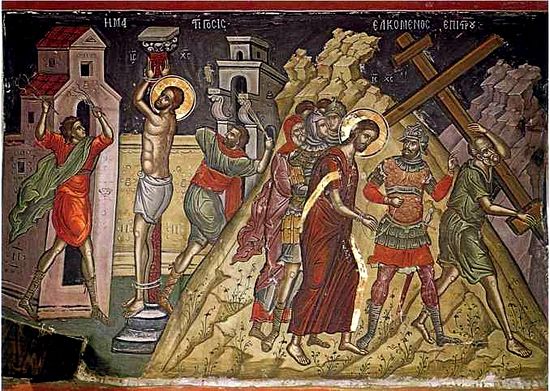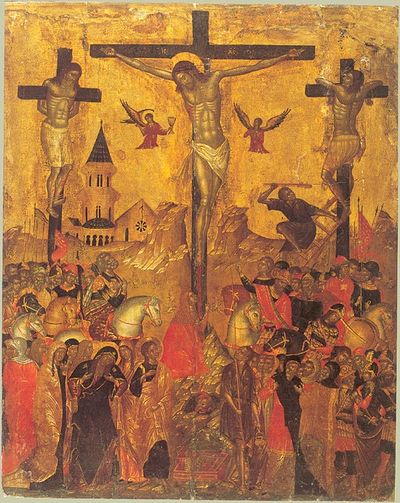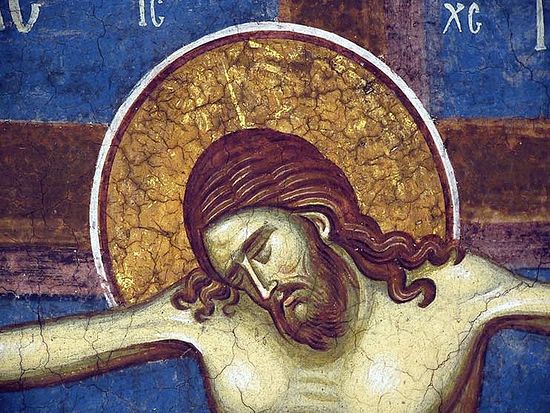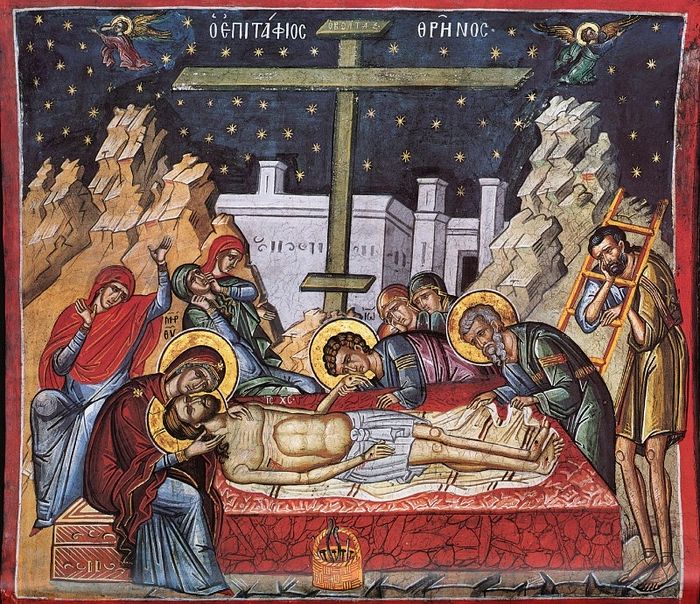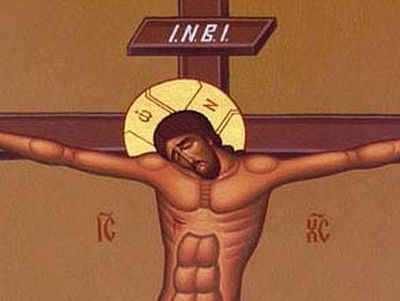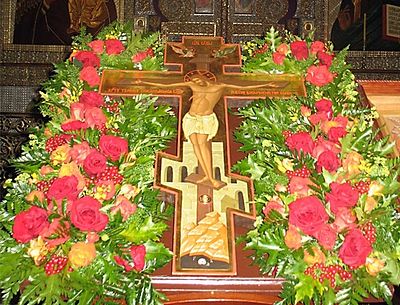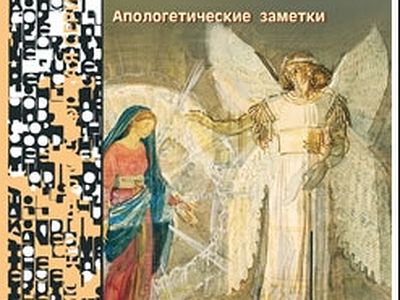After the scourging and mocking, the soldiers removed the cloak from Jesus Christ, dressed Him in His habitual raiment and led Him to be crucified. On the way to Golgotha they met one Simon, of Cyrene, returning from his fields to the city, and forced him to carry Christ’s cross the rest of the way to the place of execution. It was customary for those condemned to be crucified to carry their own cross. But the Lord was so worn out with the internal conflict in Gethsemane, the sleepless night and the inhuman torture, that He had no strength left to carry His cross any further. The enemies made Simon carry the Lord’s cross not from sympathy, of course, but from the desire to complete their deed faster. (Simon was an immigrant from Cyrene, a city in Libya, on the north shore of Africa). His sons, Alexander and Rufus, were well-known Christians, and the Apostle Paul mentions them in his letter to the Romans.
A great number of devout men and women followed Jesus Christ, and cried for Him. Their expressed compassion was so deep and sincere that the Lord found it necessary to give them some comfort. This occurred, apparently, during the halt when Christ’s cross was being transferred to Simon of Cyrene. Daughters of Jerusalem, weep not for me, but weep for yourselves, and for your children (Luke 23:28). Here the Lord, forgetting his own sufferings, turns His spiritual vision to the future of the Jewish people — to the punishment which will befall them for the fearful curse which the Jews themselves brought so lightly upon themselves, crying: His blood be on us, and on our children. For the days were coming, when the blessing of childbearing will turn into grief, and the barren will be considered blessed. Then shall they begin to say to the mountains, fall on us; and to the hills, Cover us — so great will the disasters be. Here again the speech refers to the destruction of Jerusalem by Titus in 70AD. For if they do these things in a green tree, what shall be done in the dry? This is apparently a folk saying. The Lord refers to Himself as the "green tree" full of life, but the "dry tree" refers to the Jewish people. If He, the Innocent, was not given mercy, what would become of the guilty people? Behold, I will kindle a fire in thee, and it shall devour every green tree in thee, and every dry tree: the flaming flame shall not be quenched, and all faces from the south to the north shall be burned therein (Ezekiel 20:47).
Crucifixion
The Lord was brought to the place called Golgotha, which means "the place of the skull" and there He was crucified between two robbers who were brought with him. Golgotha is a small hill, found at that time outside the city walls of Jerusalem to the southwest. It is presumed that this hill was called "the place of the skull" because the skulls of the executed often lay at its base. The Apostle Paul in his letters to the Hebrews (13:11-12) points out the special meaning of the fact that Jesus suffered without the gate. When Jesus was brought to Golgotha, they gave Him wine with myrrh (or vinegar with bile). This was wine into which myrrh (one form of tar) was added, in order to dull the consciousness of the condemned and thus relieve his torture. The Romans called such a wine soporific. Myrrh gave the wine a bitter taste, which is why St. Mark calls it bile, and the wine, probably soured — vinegar. And when He had tasted thereof, He would not drink, desiring to endure His cup of suffering fully conscious to the end.
It was the third hour, and the sixth hour was only beginning (in the sense of the second quarter of the day). (Day and night were divided into four watches. If one can suppose that the verdict of Pilate was pronounced around the third hour (nine o’clock in the morning our time), then the Apostle John could certainly say, that Christ was crucified in the sixth hour. In this way there is no contradiction in the witnessing of the Evangelists). And they crucified Him. Crucifixions were carried out differently: sometimes nailing to a cross lying on the ground, after which the cross was lifted and placed in the ground vertically; sometimes the cross was raised first, after which the condemned was lifted and nailed to it, or tied to it with ropes. Sometimes crucifixions were performed head down (thus the apostle Peter was crucified by his own wish). The hands and feet were sometimes nailed, sometimes tied. The body of the crucified helplessly hung from the cross. In terrible convulsions, all the muscles would cramp in torturous spasms; the wounds from the nail tore from the weight of the body; the executed was tormented by unbearable thirst as a result of the fever brought on by the wounds and loss of blood. The sufferings of the crucified were so great and torturous, and also prolonged (sometimes the crucified hung on the crosses, not dying three days or more), that this execution was performed only on the most dangerous criminals. It was considered the most horrible and shameful of deaths. In order that the arms not tear apart prematurely from the wounds, a support crossbar was sometimes placed under the feet on which the crucified could stand. Above the head of the crucified was added a small board denoting the crime.
The Lord did not remain completely silent amid these indescribably sufferings. The first words of the Lord were a prayer for His crucifiers: Father, forgive them; for they know not what they do. None of those soldiers crucifying Him knew that He was the Son of God. For had they known it, they would not have crucified the Lord of glory (1 Cor. 2:8), states the Apostle Paul, and even to the Jews Peter says at the healing of the lame one: I wot that through ignorance ye did it (Acts 3:17). Still, this ignorance of the Jews did not justify their crime, because they had the opportunity and means of finding out Who He is. The Lord’s prayer witnesses the greatness of His spirit and serves as an example to us not to take revenge against our enemies, but to pray for them.
By order of Pilate, a board was nailed to the cross declaring the Lord’s crime. Wishing to once again pique the members of the Sanhedrin, Pilate ordered that This is Jesus the King of the Jews be written on it. The Judean King is crucified by the demand of the representatives of the Jewish people. This sign was written in three languages: Hebrew — the local language, Greek — the universal language, and Roman — the language of the conquerors. Pilate wanted everyone to know the reason the leaders condemned Christ. But at the same time Pilate unwittingly fulfilled a higher goal: at the moment of His greatest humiliation, the Lord Jesus Christ was proclaimed King for all the world to see. The accusers of the Lord took this sign as a cruel jibe and demanded that Pilate change it, but the proud Roman harshly refused, reminding them that he is the ruler.
And when they had crucified Him, they parted His garments, casting lots upon them, what every man should take… The Roman law gave the belongings of the condemned to the soldiers performing the execution. There were four carrying out the execution. The soldiers split the outer clothing among themselves, tearing it into four parts, but the inner clothing (the coat) was handwoven as a single piece from top to bottom, with no seams. Thus they unwittingly fulfilled the ancient prophecy of David concerning the crucifixion of the Messiah: They parted my garments among them, and cast lots upon my vesture (the entire 22nd psalm is devoted to the sufferings of the crucified Lord).
Even after achieving the crucifixion of the Lord, the high priests with the scribes and Pharisees could not settle down and continued to mock Him. Mocking Jesus, they ridiculed everything that He ever said or did. For example, remembering that He used to save others, they reproached Him in His current helplessness and jeeringly suggested that Him come down from the cross, hypocritically promising to believe in Him in that case. They even reproached Him for always believing in God: He trusted in God; let Him deliver Him now, if He will have Him.
At first the robbers, hanging on both sides of the Savior and hearing how the surrounding leaders vilified the Lord, joined them and also abused the Lord. And one of them, suffering, grew meaner and abused Christ more and more harshly. Then his friend, in whom the spark of goodness had apparently not gone out completely, began to reproach his companion, saying: Dost thou not fear God, seeing thou art in the same condemnation? And we indeed justly; for we receive the due reward of our deeds: but this man hath done nothing amiss. Apparently, the reproaches of the leaders that Christ used to save other influenced him, as well as the fact the Christ meekly prayed for His crucifiers and appealed to God as to His Father. One way or the other, his conscience spoke loudly and he openly defended the Lord among the abuse and jeers of the mob. Such a decisive turning point in his soul occurred that he, believing in the crucified Jesus as the Messiah, turned to Him with the penitent words: Lord, remember me when Thou comest into Thy kingdom! When You come to the Father in Your Kingdom of glory, then remember about me the unfortunate who shared these terrible sufferings with You.
The robber did not ask for reward or glory, only prayed for mercy in that world, into which he was preparing to go. From that time the repentance of the robber became an example for all believers in Christ. His faith must have been great. The One suffering, worn out, dying, he recognized as a King returning to His Heavenly Kingdom. This was an espousal, which was not possible even for the nearest disciples of the Lord, who could not accept the idea of a suffering Messiah. Undoubtedly this was a special act of God’s grace enlightening the robber to make him an example for all sinners. This confession earned him a great reward, greater than the robber dared expect. Today shalt thou be with me in paradise — said the Lord to him. Thus, the wise robber became the first to be saved.
When the enemies began to disperse little by little, the Ever-holy Virgin Mary, Mary Cleophas, Mary Magdalene and the disciple, whom he loved (John the Theologian calls himself this). With the departure of Christ from this world, His Ever-pure Mother would remain alone and there would no longer be anyone to look after Her, and so with the words directed to the Virgin Mary: Woman, behold thy son, and to the Apostle John: Behold thy Mother, the Lord entrusts His Ever-pure Mother to His beloved disciple. And from that hour that disciple took Her unto his own home, caring for Her, as a loving son. (This event is important for the following reason. The sectarians, not believing in the virginity of the Mother of God, say that after Jesus Christ She had other children, born in the usual manner from Joseph, and that these were the “brothers of the Lord," which are mentioned in the Gospels. But then it must be asked: if the Mother of God had natural children, why entrust Her for safekeeping to St. John the Theologian?).
The Death of Christ
The death of the Lord was preceded by darkness, covering the earth. And it was about the sixth hour, and there was a darkness over all the earth until the ninth hour, that is, by our clock, the sun dimmed from noon until three o’clock. This could not have been a natural solar eclipse, because on the Jewish Passover, the 14th day of the month of Nisan, there is always a full moon, and a solar eclipse only occurs during new moons. This was a miraculous eclipse, which testified to an extraordinary event — the death of the beloved Son of God. Phlegon, the Roman astronomer, and also the Greek historian Phallos recorded the unexpected solar eclipse, during which the stars were visible. Dionysius the Areopagite mentions it in his letters. Apparently, the darkness, which followed the derision and ridicule of the Lord, put an end to this derision and caused the people to regret their act, And all the people that came together to that sight, beholding the things which were done, smote their breasts and returned (Luke 23:48).
And at the ninth hour Jesus cried with a loud voice, saying, "My God, my God, why has Thou forsaken Me?" The word "God" in Aramaic is pronounced "Eloi" or "Eli," as written by the Evangelists. This cry was the expression of the God-man’s deepest sorrow. In order for the sacrifice for salvation to occur, it was necessary that the God-man drink the full cup of human suffering. For this it was necessary that the crucified Jesus not feel the joy of His unity with God the Father for a time. All of God’s anger, which should have been directed towards sinful humanity, was now concentrated on Christ alone, and it was as if God the Father had abandoned His beloved Son. Amid the worst physical and spiritual sufferings, this abandonment was the most torturous, which is why it drew this painful cry from Jesus’ lips.
When Jesus panted I thirst, one of the soldiers immediately took a sponge, filled it with vinegar and, putting it on a reed, gave Him to drink. The soldier put the sponge on a reed, because those hanging on crosses were found rather high off the ground. The Psalm-singer in the 69th psalm, verse 21, predicts the sufferings of the Messiah, saying in His name: In My thirst they gave Me vinegar to drink. When he had drunk the vinegar, the Lord said, It is finished, that is: My work is done, which was predetermined in the Council of the Holy Trinity and predicted by the prophets — the reconciliation of the human race with God is accomplished through My death. After this, the Lord cried: Father, into Thy hands I commend My spirit, and, bowing His head, gave up the ghost.
At this same moment the curtain that divided the Sanctuary from the Holy of Holies in the Temple tore in half from top to bottom. As this was the time of the offering of the evening sacrifice (3 o’clock our time), the priests could not have avoided seeing this occurrence. It symbolized the conclusion of the Old Testament and the beginning of the New Testament.
There was also an earthquake at this time that split the cliffs on the neighboring hills and opened the burial chambers. By crucifying the Son of God, people committed such a horrible crime that even lifeless nature shuddered. Then, as a sign of the Lord’s victory over death, many bodies of the saints which slept arose and appeared in Jerusalem to people who knew them on the third day after the Lord’s resurrection. These miraculous signs caused such a staggering reaction in the Roman centurion that he exclaimed, Truly this was the Son of God! According to legend, this centurion, called Longinus, became a Christian and later suffered as a martyr for Christ. The people remaining on Golgotha until this time were shaken as well; they smote their breasts, and returned. Such extreme changes from one mood to another is natural in an excited crowd.
Witnessing the Lord’s death and all these events were many women who had followed Jesus from Galilee. Among them were: Mary Magdalene, Mary (mother of James and Joses) and Salome, mother of the sons of Zebedee (the apostles James and John). As it was Friday (in Greek "paraskevi," which means preparation, that is, the day before Saturday), and that Saturday (sabbath) was a "high day," as it coincided with the first day of Passover, the members of the Sanhedrin asked Pilate that their legs might be broken (the bone below the knee), in order that the bodies of those crucified not remain on the crosses.
Of all the types of executions, crucifixion on the cross was the most torturous. The crucified could not die immediately, but suffered many days, pulling themselves up on pierced arms and legs in order to breathe air. Finally as a rule they died of suffocation, not having any more strength to pull themselves up on the cross. To accelerate death the legs of the crucified were broken. Upon gaining permission from Pilate, the soldiers broke the legs of the robbers, who were still alive. But when they came to Jesus, and saw that he was dead already, they brake not his legs: but one of the soldiers with a spear pierced his side, and forthwith came there out blood and water.
Apparently this emission of blood and water was the result of the feverish state which the dying on the cross experience. Nonetheless the apostle John sees a miraculous phenomenon even in this, underlying that he that saw it bare record, and his record is true (John 19:35). The most pure body of the God-man was not subject to the laws of decomposition of a normal human body. From the very minute of death it began to enter that state, which ended with His Resurrection in the new, glorified, energized form. The Holy Fathers explain that this pouring out of blood and water symbolizes the renewal of the faithful in the mysteries of baptism and the Eucharist: We are born with water, and are nourished with blood and body (the Apostle John reminds us of this in his letter: This is he that came by water and blood, even Jesus Christ; not by water only, but by water and blood. And it is the Spirit that beareth witness, because the Spirit is truth… And there are three that bear witness in earth, the spirit, and the water, and the blood (1 John 5:6-8).
The Apostle John sees the fact that the soldiers did not break the legs of Jesus as the fulfillment of the demands of Scripture regarding the killing of the Passover lamb: Neither shall ye break a bone thereof (Exodus 12:46). The Passover lamb, as the prototype of the Lord Jesus, had to be eaten without breaking bones, and the rest was supposed to be burned. The Apostle also presents the prophecy of Zechariah regarding the piercing of the ribs of the Savior: And they shall look upon me whom they have pierced (Zech. 12:10). Here the Jehovah-Messiah is presented as one pierced by the Hebrew nation. The nation later brings its repentance before the Pierced with tears and crying. These words were fulfilled at the moment of Christ’s death and will be fulfilled a second time before the end of the world, when many Jews will turn to Christ. (See the predictions of the Apostle Paul in the letter to the Romans 11:25-26).
The Burial of the Lord Jesus Christ.
The burial of the body of Christ took place in the early evening, before the beginning of the feast of Passover. Joseph (a member of the Sanhedrin) of Arimathea (a city near Jerusalem) came to Pilate. He was a pious person, a secret disciple of Christ who did not participate in the judging of the Lord. He asked Pilate for the body of Jesus for burial. According to Roman practice, the bodies of the crucified were left on the crosses and became food for the birds. Pilate was surprised that Jesus was already dead, as those crucified sometimes hung for several days, but after checking with the centurion who confirmed Jesus’ death, commanded that the body be given to Joseph. Nicodemus, who had once visited Jesus at night, also came for the burial. He brought approximately 100 pounds of a mixture of myrrh and aloe with him. Joseph also bought a linen shroud — a long and expensive material. Joseph and Nicodemus removed the Body from the cross, covered it with the sweet-smelling spices according to custom, wrapped it in the shroud and laid it in a new burial cave in Joseph’s garden not far from Golgotha.
The sun was already in the west, and though everything was done diligently, it was done very quickly. They departed after rolling a stone before the entrance of the grave. The women who were previously at Golgotha stood observing all of this.
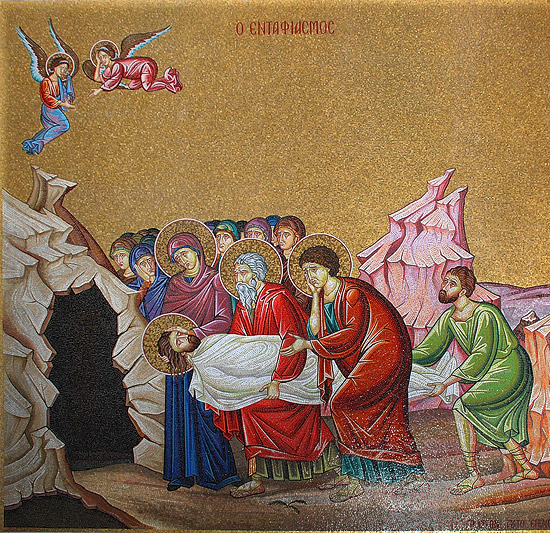 The Entombment of Christ. Mosaic Church of the Resurrection in Jerusalem. Photo: A.Pospelov / Pravoslavie.Ru
The Entombment of Christ. Mosaic Church of the Resurrection in Jerusalem. Photo: A.Pospelov / Pravoslavie.Ru
